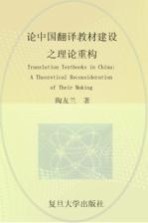图书介绍
论中国翻译教材建设之理论重构2025|PDF|Epub|txt|kindle电子书版本网盘下载

- 陶友兰著 著
- 出版社: 上海:复旦大学出版社
- ISBN:9787309062243
- 出版时间:2008
- 标注页数:315页
- 文件大小:17MB
- 文件页数:334页
- 主题词:英语-翻译-高等学校-教材-研究
PDF下载
下载说明
论中国翻译教材建设之理论重构PDF格式电子书版下载
下载的文件为RAR压缩包。需要使用解压软件进行解压得到PDF格式图书。建议使用BT下载工具Free Download Manager进行下载,简称FDM(免费,没有广告,支持多平台)。本站资源全部打包为BT种子。所以需要使用专业的BT下载软件进行下载。如BitComet qBittorrent uTorrent等BT下载工具。迅雷目前由于本站不是热门资源。不推荐使用!后期资源热门了。安装了迅雷也可以迅雷进行下载!
(文件页数 要大于 标注页数,上中下等多册电子书除外)
注意:本站所有压缩包均有解压码: 点击下载压缩包解压工具
图书目录
Figure 0-1 A model of translation competence for second language learners10
Figure 1-1 Holmes'basic"map"of Translation Studies28
Figure 1-2 Munday's interpretation of Translation Studies28
Figure 1-3 Liu's interpretation of Translation Studies29
Figure 1-4 Tao's interpretation of Translation Studies33
Figure 2-1 Factors that determine the skopos45
Figure 2-2 Factors that influence readability61
Figure 2-3 The marketing mix(adapted from Palmer,2004)69
Figure 2-4 Basic theories supporting translation textbook compilation73
Figure 3-1 The position of a syllabus in the whole process of teaching75
Figure 3-2 Categorization of syllabus(adapted from Cheng Xiaotang 2002:17)79
Figure 3-3 Roles of teachers81
Figure 3-4 Factors influencing the making of translation textbooks135
Figure 4-1 Recommended steps for setting up and implementing a translation teaching program(adapted from Jordan 1997:57)141
Figure 4-2 Methods of collecting data for needs analysis(Jordan 1997:39)144
Figure 4-3 A framework of new needs analysis(Masuhara,1998)149
Figure 4-4 A translation-competence-based approach to course design(translated from Wen Jun 2005:12)158
Figure 4-5 Types of translation188
Figure 4-6 Cognitive factors influencing the designing of translation exercises(adapted from ELT Journal Vol.43/1,1989:4-5)228
Figure 6-1 A theoretical framework of making a translation textbook268
Table 5-1 A glance of representative translation textbooks in China(1980-2008)248
Introduction1
0.1 Background of the study1
0.2 Definition of some terms3
0.3 Description of methodology13
0.4 Organization of the contents14
Chapter 1 A Survey of Translation Textbook Studies18
1.0 Introduction18
1.1 Translation textbook studies in the West18
1.2 Translation textbook studies in China21
1.3 Comments on the related studies both at home and abroad23
1.4 The positioning of translation textbook compilation25
1.5 Conclusion34
Chapter 2 Basic Theories Supporting the Making of Translation Textbooks35
2.0 Introduction35
2.1 Skopostheorie35
2.1.1 A brief introduction of skopostheorie35
2.1.2 Skopostheorie and the making of translation textbooks39
2.2 Communication theory48
2.2.1 A brief introduction of communication theory48
2.2.2 Communication theory and the making of translation textbooks49
2.3 Psycho-educational theories52
2.3.1 A brief introduction of related psycho-educational theories52
2.3.2 Psycho-educational theories and the making of translation textbooks57
2.4 Readability theory58
2.4.1 A brief introduction of readability theory58
2.4.2 Readability theory and the making of translation textbooks64
2.5 Marketing theories66
2.5.1 A brief introduction of marketing theories66
2.5.2 Marketing theories and the making of translation textbooks69
2.6 Conclusion72
Chapter 3 Factors Influencing the Making of Translation Textbooks74
3.0 Introduction74
3.1 Syllabus74
3.1.1 Types of syllabus74
3.1.2 Syllabus and the making of translation textbooks79
3.2 Teachers80
3.2.1 The role of teachers81
3.2.2 Teachers,methodology and textbooks82
3.2.3 Translation teachers and the making of translation textbooks83
3.3 Students86
3.3.1 The roles of students86
3.3.2 Students,methodology and textbooks88
3.3.3 Students and the making of translation textbooks89
3.4 Linguistic and language studies92
3.4.1 Traditional grammar and the making of translation textbooks93
3.4.2 Structural grammar and the making of translation textbooks95
3.4.3 Functional grammar and the making of translation textbooks98
3.4.4 Semiotics and the making of translation textbooks101
3.4.5 Semantics and the making of translation textbooks104
3.4.6 Text linguistics and the making of translation textbooks106
3.5 Translation Theories108
3.5.1 Chinese translation theories and the making of translation textbooks109
3.5.2 Western translation theories and the making of translation textbooks118
3.6 Social and cultural factors126
3.6.1 Social contexts and the making of translation textbooks126
3.6.2 Market demands and the making of translation textbooks128
3.6.3 Cultural turn in translation studies and the making of translation textbooks130
3.7 Conclusion134
Chapter 4 Developing Translation Textbooks136
4.0 Introduction136
4.1 Needs analysis136
4.1.1 Classification of needs136
4.1.2 The role of needs analysis140
4.1.3 Methods for needs analysis144
4.2 Approaches to designing translation textbooks150
4.2.1 Language-based approach150
4.2.2 Skills-based approach154
4.2.3 Translation-competence-based approach158
4.3 Principles of designing translation textbooks163
4.3.1 The principle of emphasizing the practice167
4.3.2 The principle of being guided by macro translation theories167
4.3.3 The principle of borrowing theories from other disciplines168
4.3.4 The principle of keeping up with the times169
4.3.5 The principle of user-friendliness and market orientation170
4.4 The Designing of the Components of Translation Textbooks171
4.4.1 The designing of translation theories171
4.4.2 The designing of translation methods186
4.4.3 The designing of translation techniques198
4.4.4 The designing of translation exercises213
4.5 Conclusion232
Chapter 5 Reflections on Translation Textbooks and Suggestions for Their Making235
5.0 Introduction235
5.1 A glance at translation textbooks in the West235
5.2 The implications for translation textbook making in China238
5.3 A survey of translation textbooks in China240
5.4 Comments on the established translation textbooks in China249
5.5 Suggestions for translation textbook making in China254
5.6 Conclusion259
Conclusion261
Notes269
Bibliography275
AppendixⅠ.本书中涉及的主要教材299
Ⅱ.中国大陆主要英汉、汉英翻译教材目录(1980—2008)301
Ⅲ.国内外有关翻译教材研究的主要文章和著作目录(1980—2008)307
Ⅳ.本科生翻译教材编写者调查问卷312
Ⅴ.翻译教材调查问卷313